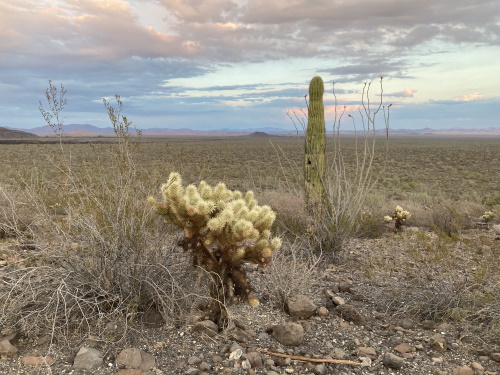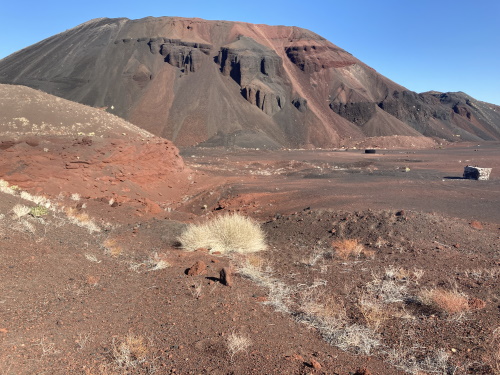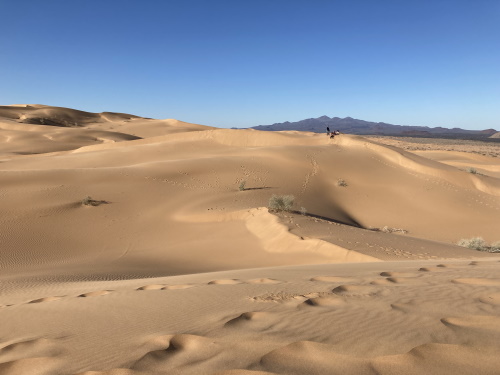Blog WHS Visits
WHS #771: EPGDABR
EPGDABR, short for “El Pinacate and Gran Desierto de Altar National Biosphere Reserve”, is another rarely visited WHS in the far North of Mexico. After contemplating a lot of options on how to get there (Fly to Mexicali and rent a car? Take a bus the loooong way west from Chihuahua?), I stumbled upon a 2-day / 1-night camping tour out of the Sonoran state capital of Hermosillo. It ticked all my boxes as it would cover both the sand dunes (Gran Desierto) and the volcanic landscape (El Pinacate), provide transport & lodging, and it was cheap and convenient as well. This WHS is complicated in many ways, so brace yourself for a long review.
The first question that needs to be answered is “What is it exactly about?”. The landscape is a mix of volcanic craters, cactuses, high sand dunes, and starry nights, all in the Sonoran Desert. As the long name already suggests, it covers actually two adjacent areas with different values. I can see that for management purposes they have been linked, but it does feel like visiting two different sites. El Pinacate I would describe as “Iceland with cactuses”, while the Gran Desierto de Altar is like a smaller version of the Namib Sand Sea. The fabled “stark contrast of a dark-coloured area comprised of a volcanic shield and spectacular craters and lava flows within an immense sea of dunes” (OUV Statement) I found a bit prosaic, as the two areas only touch at certain points.
Its main volcanic features are the Maar craters: shallow craters formed by steam blasts. We visited Cerro Colorado (known for its colouring during sunset) and El Elegante (just a pretty one!). Note that it took at least an hour on a bumpy unpaved road to reach Cerro Colorado, and the other ones are even deeper inside the Reserve. The circuit is signposted, there are car parks and an easy hiking trail will get you to the edge of the craters. We didn’t encounter any other tourists during our visit to El Pinacate, we only met one park ranger on patrol by car.
There is a campground inside the park, in an area called Tecolote. It is nothing more than a flat area to pitch your tent plus a few benches and fire pits. It easily had space for our 15 tents. Only after a dog came begging in the evening when we had sausages roasting on the fire, we noticed that we had neighbours as well: 2 females (+ dog) in a van. The camp area also has two short trails and two smaller volcanic cones to climb.
In the 1940s and 1950s, parts of the area have been mined for its volcanic rock and pyroclastic material. It was used to build highway #2 and for construction purposes. Cinder mining has ceased since it was declared a national Biosphere Reserve, but it has left it with another colourful attraction. The Laja cone (see 2nd photo) shows its rusty-red colours due to the high iron levels. The top of the cone has collapsed due to mining.
When you stand on top of one of the volcanic cones and scan the surrounding desert, your eyes cannot evade the brown stripe in the distance to the north. It is what the Mexicans call “The Wall of Trump”. Actually more a fence, it is the physical border that was built from 2020 on. As it limits the “connectivity and movement of key wildlife populations, such as the Sonoran Pronghorn and the Bighorn Sheep”, the WHC in its last session has urged the US and Mexico to an “assessment of impacts that the construction works might have already had on the OUV of the property”. Although I can see that the Mexicans find the whole construction an unnecessary provocation, it must be said that the aforementioned highway #2 on the Mexican side also is an eyesore with its continuous flow of white trucks. Many sheep will have been killed there as well. We did not see one mammal by the way, during our full 26-hour visit to the site.
The fence doesn’t only limit the movements of larger animals between Mexico and the USA, it was meant to prevent human migration. The Reserve’s Schuk Toak Visitors Center does focus on the story of the Tohono O’odham, the native people of the area. Maps show how they used a network of ancient salt trails to get around this barren region. One wonders whether the site couldn’t have been proposed as a cultural landscape as well.
A few km beyond the Visitors Center, the sand dunes start. My tour mates liked this part of the tour the best, for me, it was a bit of “Been There, Done That”. It’s a hot walk for about 2km through the desert until you reach the golden sands. Its specialty is the very large star dunes, with sharp edges created by winds coming from many different directions. There were a few other US and Mexican day-trippers here as well, with a total of five cars in the parking lot.
In hindsight, I can think of 3 good ways of getting there & around:
- When you’re a confident driver on unpaved roads (with experience in Namibia and Botswana for example), you can explore the park in a rental car with high clearance. In case of need, there is cell phone reception in the areas on higher ground.
- You can do the same camping tour as I did. I found it well-organized. The amenities are fairly basic though, and the ride from and to Hermosillo is long (6+ hours).
- Base yourself in Puerto Penasco and try to find a full-day private tour with a driver/guide.
I doubted whether to award the site with a 3.5 or 4-star rating. Usually, I reserve 4 stars for the WHS where I have a real WOW!-moment and can clearly see the OUV. Here I only had a short WOW! at El Elegante crater at sunset. The volcanic and desert features certainly are good, but are they globally outstanding? Both scores combined, I go for a 3.5. But anyway it is a very interesting and satisfying place to visit, that has left me pondering about so many subjects. And I even didn't start writing on the issue of land ownership... or the many species of cactus (including the 'dancing' saguaro).
Els - 6 February 2022
Comments
Esteban Cervantes Jiménez 9 February 2022
Well, it's great to see that you enjoyed this site and had a taste of the 2 different areas. When it was inscribed, I was very happy about it and, in general, thinking on Mexico's TL, I consider there is potential for additional Mexican Natural WHS.
Tamara Ratz 6 February 2022
Thank you so much, I've come to the site today to find information about this WH, I couldn't believe my eyes when I found your review on the front page :)
Els Slots 6 February 2022
Thanks to your enthusiastic reviews, Kyle, I made a special effort for a "good" visit.
Kyle Magnuson 6 February 2022
Great review! I am so happy you made it out there. It's a special place for me, perhaps I am particularly fond of the desert. Your experience with a camping tour sounds like a useful way to see the reserve.


